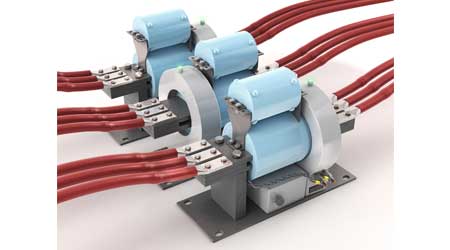« Facilities Technology Briefs Home /
Power & Communication
Current Protector Reduces Risk of Arc Flash Incidents - G&W Electric Inc. - Facility Management Product Release

G&W Electric Inc.
website
| Company information
The CLiP®-LV current limiting protector joins an expanded line of current limiting protectors, an electronically triggered commutating form of current limitation, generically referred to as Is-Limiters. When an overcurrent condition occurs, the unit senses it and quickly opens the bus bar, transferring or commutating the current to a parallel, low-continuous rated current-limiting fuse that interrupts the fault.
The protector is presently rated for continuous currents of 4, 000 amperes in applications to 750 VAC. This product incorporates field resettable trigger level ranges and interrupt capabilities up to 100kA. Typical applications include arc flash and arc blast mitigation, protecting overdutied equipment, bus tie closure and overcurrent protection of system components such as circuit breakers, generators, transformers, capacitor banks and variable speed drives.
Because the CLiP-LV also protects against bolted faults, it prevents severe stress that can shorten the life of source side generators, breakers and transformers. This includes protection against cumulative transformer through-fault damage.
As the demand for electrical power increases, distribution systems are expanded to accommodate the increased demand. Stiffened transmission systems, increased substation capacity, and added on-site and distributed generation all contribute to increases in available fault currents. Often these currents exceed the capability of the electrical equipment, putting the equipment and maintenance personnel at risk for a catastrophic event. Current limitation dramatically reduces the magnitude of the peak let-through current and the system energy, protecting equipment from costly failure and protecting workers from dangerous arc flash.
The CLiP-LV senses faults electronically, permitting a more specific and predictable operating point than traditional fuses, and the parallel current-limiting fuse of the CLiP-LV is not subject to aging, as seen with traditional fuses. Furthermore, pre-conditioning (performance curve shifting) does not occur with the CLiP-LV as it does with traditional fuses. Moreover, in the event of a fault, many applications require replacement of the fuses on all three phases; a current limiter will trigger only on the faulted phase, reducing replacement costs on single-phase and two-phase faults.
The CLiP-LV offers advantages over competing commutating limiters. Its interrupter features a 20-year rated life versus 5-7 years. Unlike other protectors, it does not require an enclosure, resulting in a more compact solution. Its hardened transient filtering responds only to current, not high frequency transients or harmonics, unlike transient-susceptible di/dt sensing.
The new protector has a number of other features, such as near identical peak let-though values regardless of fault asymmetry level. It has field selectable trigger levels that let users adjust its operating values as site characteristics change, ensuring continued protection over the life of the device. It has remote trip indication and local LED indication of operational status.
RELATED CONTENT
Content Category: Power & Communication
FEATURES:
QUICK READS:
posted: 7/17/2015








